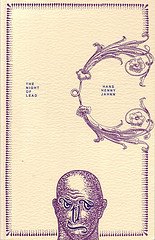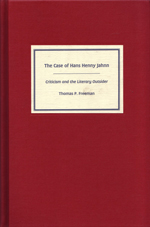 Hans Henny Jahnn's Thirteen Uncanny Stories, trans. Gerda Jordan (Peter Lang, 1984, now out-of-print, though copies still pop up).
Hans Henny Jahnn's Thirteen Uncanny Stories, trans. Gerda Jordan (Peter Lang, 1984, now out-of-print, though copies still pop up).In her introduction, Gerda Jordan explains the title:
"The stories presented in this volume were selected by Jahnn from [his novels] Perrudja [1929] and Fluß ohne Ufer* and published in a separate volume in 1954. Their collective title, Thirteen Uncanny Stories (13 nicht geheure Geschichten) is misleading and may have been chosen as a catch word for selling purposes. They are in no way 'uncanny' in the light of Jahnn's philosophy and of his entire work. In the two novels they appear in various contexts, for example, as reading of history, 'Sassanidian King'; as entertainment at a sick-bed, 'The Slave's Story'; as a memory, 'A Boy Weeps.' This selection shows a cross section of various themes, or rather of Jahnn's variation on one theme, as well as a cross-section of his varied styles, from terse, saga-like compactness to the highly ornamental language of the Baroque."
Contents:
Introduction by Gerda Jordan (21 pages)
1. Ragna and Nils (from Perrudja)
2. The Slave's Story (from Perrudja)
3. The Watchmaker (from Fluß ohne Ufer)
4. Sassanidian King (from Perrudja)
5. The Gardener (from Fluß ohne Ufer)
6. The Story of the Twins (from Perrudja)
7. A Boy Weeps (from Perrudja)
8. Kebad Kenya (from Fluß ohne Ufer)
9. The Marmalade Eaters (from Perrudja)
10. Mov (from Fluß ohne Ufer)
11. A Master Selects His Servant (from Fluß ohne Ufer)
12. The Diver (from Fluß ohne Ufer)
13. Stolen Horses (from Fluß ohne Ufer)
I haven't read The Ship recently enough to know which selections from Fluß ohne Ufer (besides Kebad Kenya) are contained in that volume. I suspect at least a few of them are from Die Niederschrift des Gustav Anias Horn (see below), which would make them the only sections of that book in English.

*Let me break down what I know about Fluß ohne Ufer, which in English would be "River Without Shore," or "The Shoreless River."
It is a trilogy:
--The first part, Das Holzschiff, was published in 1937. It was translated as The Ship by Catherine Hutter in 1961 (Scribners).
--The second part was published in 1949-50 as Die Niederschrift des Gustav Anias Horn [The Writings of Gustav Anias Horn]. It has never been translated.
--The third part, Epilog, appeared in 1961. It has never been translated.
Das Holzschiff is a normal-length novel. The other two volumes are apparently massive, sprawling works.
















